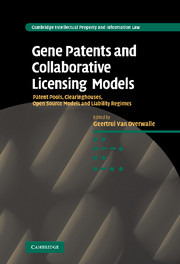 Gene Patents and Collaborative Licensing Models
Gene Patents and Collaborative Licensing Models Book contents
- Frontmatter
- Contents
- List of contributors
- Preface
- Foreword: Jean-Jacques Cassiman
- List of abbreviations
- Part I Patent pools
- Part II Clearinghouses
- Part III Open source models
- Part IV Liability regimes
- 17 Pathways across the valley of death. Novel intellectual property strategies for accelerated drug discovery
- 18 Case 10. The International Treaty on Plant Genetic Resources for Food and Agriculture (ITPGRFA). The Standard Material Transfer Agreement as implementation of a limited compensatory liability regime
- 19 Critical analysis: property rules, liability rules and molecular futures. Bargaining in the shadow of the cathedral
- Part V Different perspectives
- Part VI Summary and concluding analysis
- Index
- Titles in the series
18 - Case 10. The International Treaty on Plant Genetic Resources for Food and Agriculture (ITPGRFA). The Standard Material Transfer Agreement as implementation of a limited compensatory liability regime
from Part IV - Liability regimes
Published online by Cambridge University Press: 14 January 2010
- Frontmatter
- Contents
- List of contributors
- Preface
- Foreword: Jean-Jacques Cassiman
- List of abbreviations
- Part I Patent pools
- Part II Clearinghouses
- Part III Open source models
- Part IV Liability regimes
- 17 Pathways across the valley of death. Novel intellectual property strategies for accelerated drug discovery
- 18 Case 10. The International Treaty on Plant Genetic Resources for Food and Agriculture (ITPGRFA). The Standard Material Transfer Agreement as implementation of a limited compensatory liability regime
- 19 Critical analysis: property rules, liability rules and molecular futures. Bargaining in the shadow of the cathedral
- Part V Different perspectives
- Part VI Summary and concluding analysis
- Index
- Titles in the series
Summary
Introduction
Exchange of crop germplasm, usually in the form of seeds, is essential to obtain new sources of disease and pest resistance, improved nutritional characteristics and other desirable and necessary traits, in the breeding of crops grown to provide food for the sustenance of humanity. Historically, seeds, as well as slips and tubers for propagation have been carried by travellers of all sorts – farmers, explorers and adventurers – to share with crop breeders who eagerly await new inputs as they attempt to provide seeds and plant materials that fit the current needs of local farmers. Farmers and other breeders of crop varieties have always depended upon exchange of seeds as a reservoir of inherited characteristics as the history of every domesticated crop shows. Breeding pedigrees of spring bread wheats, for example, have shown that up to 4,500 different parental combinations, involving the contributions of 3,800–4,000 original parents, were used to produce one variety of wheat that was released in India. Although wheat originated from the fertile crescent of Mesopotamia ∼7500BC, modern varieties contain materials obtained from all over the globe. The breeding of existing materials with newly obtained genetic stocks ensures that planting materials for next year's crops contain a complement of genetic alleles (choices) that provide farmers with planting varieties resulting in the best possible yields of desirable crops.
- Type
- Chapter
- Information
- Gene Patents and Collaborative Licensing ModelsPatent Pools, Clearinghouses, Open Source Models and Liability Regimes, pp. 289 - 293Publisher: Cambridge University PressPrint publication year: 2009
